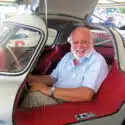Doug Nye: 80th anniversary of an illicit Motor Sport road race
“In 1944 Bill Boddy got his teeth into a remarkable ‘few days out for the boys’”
Eighty years ago, for the Allies, WW2 was ‘going well’ and in Britain serious planning had begun for postwar peace.
Perhaps symptomatic of new-found optimism, mad keen motoring enthusiasts were finding more ways to ‘forget the war’. Both the 750 MC and the VSCC had continued to organise relatively discreet ‘gatherings’ at which keen members with both a worthwhile car and the petrol to power it could re-live pre-war sporting fun. These ranged from a simple pub ‘noggin and natter’, to more overt (and official wrath-risking) timed competition –however discreet. Such active gatherings were neither frequent nor numerous, but they did take place. Little comprehensive record survives. Very few of these were reported – discreetly and certainly obliquely – in the specialist press.
One exception came in these pages in our December 1944 issue when editor Bill Boddy got his teeth into a remarkable “few days out for the boys” – which, with typical perversity, he had also enjoyed – writing as follows: “it is surprising to learn that the police recently closed certain sections of public road in Surrey in order that Bugatti racing cars could race over them.
“Not only surprising, but encouraging, because if this can happen in time of war, how can authority refuse to listen to the clamour for such a thing in peace-time, from thousands of enthusiasts, many of them straight back from Service life? Let us examine this astonishing and stimulating event in greater detail. Why did these racing cars receive assistance from the police and the military, not only to do something which only an Act of Parliament could make legal, but also be allowed to run about freely between their garage and the ‘course’ sans wings, silencers and number plates? Because a film company wished to obtain motor-racing ‘shots’ for a film to be known as ‘The Rake’s Progress’ … Apparently the Ministry of Information was able to extract the necessary petrol from the Ministry of Fuel and Power.
“A Continental GP is presumably to be featured, and the piece of twisty road used runs from Frimley Green through Deepcut Barracks to Brookwood Station. It was closed by policemen and later by armoured cars. Rodney Clarke and Leonard Potter, of Continental Cars…” (who would produce the Connaught Formula 2, GP and sports-racing cars postwar) “…provided most of the ‘cast’ comprising a Type 39 GP Bugatti, a Type 35 GP Bugatti, a Type 57 Bugatti saloon, a Type 55 Bugatti 2-seater, a Riley Sprite, a Fiat Balilla and a Morgan 4/4.
“Potter and Birkett [local vet Holly Birkett – a luminary of the 750MC] drove the GPs – alas, for some unknown reason they had to be disguised with dummy cowls, etc. Further ‘colour’ was lent by one of the orange TT Austin Sevens laying on its side in the road with a smoke-bomb inside – a sad predicament for a famous little car. All the cars were garaged at North Camp and were driven to and fro in a highly illegal state with hardly any police interference.
“Potter left the road and hit a tank trap, writing off the Bugatti”
“The cars made numerous runs up the rather Shelsley-like course, reaching about 60 or, perhaps, 65 mph, taking a nasty bend at about 40 mph, which is described by a knowledgeable onlooker as ‘middling fast’. The ‘racing drivers’ apparently received 4 shillings a day and an extra 5 to go off-the-road to order.
“The great moment came when Potter misjudged the corner unintentionally and got out of control in the Type 39 while passing the ‘burning’ Austin. Birkett, in the Type 35, had all his work cut out to avoid Potter, who left the road and hit a tank trap, pretty well writing off the Bugatti. This pleased the film people immensely, and the plot of the film is to be altered to include what will probably be one of the best ‘shots’ ever of a racing-car crash. Leonard merely cut his nose, but he was not pleased, and is believed to have blamed the skid on his unequal tyre-pressures. He was following Clarke’s stripped Riley Sprite when it happened, and the cameras got the accident from two positions.
“There should also be some good action shots within the film, a camera car – sometimes a Morgan 4/4 – following and preceding the ‘racers’. Some of the ‘shots’ were shown privately at the ‘Scala’, North Camp, shortly afterwards.”
‘The Bod’ continued: “We do not begrudge the petrol used, for it will be nice to see motor-racing in a film and it is all good publicity, unless the story spoils it. But do not forget that two Ministries, the military and the police all connived to allow a film company to over-ride the law. When we want racing on British roads after this mechanised war has been won, let us remember this fact. Incidentally, we do not suppose that the sometimes-maligned RAC Competitions Committee will refuse Competitions Licences to Clarke, Potter, Birkett and Co for this little lapse into the realm of permit-less and lawless racing…”.
Hmm, it poses a question – might lawless racing itself make a comeback should future government ban such irresponsible, wasteful and planet-damaging activity as motor sport, in all its forms?
Doug Nye is the UK’s leading motor racing historian and has been writing authoritatively about the sport since the 1960s

